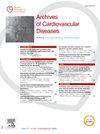Impact of SARS-CoV-2 infection on the mitochondrial network in human pluripotent stem cell-derived cardiomyocytes
IF 2.3
3区 医学
Q2 CARDIAC & CARDIOVASCULAR SYSTEMS
引用次数: 0
Abstract
Introduction
Severe Acute Respiratory Syndrome Coronavirus 2 (SARS-CoV-2) infection has been associated with cardiovascular complications, including cardiac failure, arrhythmias, and acute coronary syndromes, particularly among hospitalized patients. Elevated levels of both troponin and cell-free mitochondrial DNA in the bloodstream have been identified as biomarkers, correlating with the severity of the disease. These markers suggest that SARS-CoV-2 may induce damage to both cardiac cells and mitochondria. Given the crucial role of mitochondria in maintaining the physiological functions of cardiomyocytes, we aim to investigate the impact of SARS-CoV-2 on both cardiac cells and their mitochondrial function.
Objective
We aim to explore whether SARS-CoV-2 can directly infect cardiomyocytes and subsequently examine the extent of mitochondrial network disruptions. Finally, we will investigate the downstream consequences of these mitochondrial alterations, particularly metabolic processes and innate immune responses, which are closely tied to SARS-CoV-2 infection.
Method
We used human pluripotent stem cell-derived cardiomyocytes (HPSC-CMs) as a model to study SARS-CoV-2 infection. Infection was assessed through microscopy and viral RNA detection. We also examined changes in cellular, nuclear, and mitochondrial morphology following infection using advanced imaging techniques. Additionally, we measured alterations in RNA expression of inflammatory markers and mitochondrial genes. Finally, we used a non-cardiac cell line to confirm the ability of SARS-CoV-2 to induce mitochondrial disruptions and to investigate the viral and cellular protein factors involved in this process.
Results
Following SARS-CoV-2 infection, we confirmed viral genome presence in HPSC-CMs and observed Troponin+ and Spike+ cells. We showed that infection led to an increase of inflammation markers and a morphological perturbation of the HPSC-CMs. Both cardiac and non-cardiac cell line showed signs of mitochondrial network perturbation. We identify ORF9b, an antagonist of innate immune response, as a viral candidate for this perturbation.
Conclusion
These findings confirm that SARS-CoV-2 can directly infect cardiomyocytes, triggering an inflammatory response. The virus targets mitochondria, which play a dual role as both the primary energy source and a reservoir of compounds utilized by the virus for replication, as well as a platform for initiating innate immune responses. This interaction may provide a key mechanism underlying the cardiac injuries observed during SARS-CoV-2 infection.
SARS-CoV-2感染对人多能干细胞源性心肌细胞线粒体网络的影响
严重急性呼吸综合征冠状病毒2型(SARS-CoV-2)感染与心血管并发症相关,包括心力衰竭、心律失常和急性冠状动脉综合征,特别是在住院患者中。血液中肌钙蛋白和无细胞线粒体DNA水平升高已被确定为与疾病严重程度相关的生物标志物。这些标记表明,SARS-CoV-2可能会对心肌细胞和线粒体造成损伤。鉴于线粒体在维持心肌细胞生理功能中的关键作用,我们旨在研究SARS-CoV-2对心肌细胞及其线粒体功能的影响。目的探讨SARS-CoV-2是否可以直接感染心肌细胞,并随后检测线粒体网络破坏的程度。最后,我们将研究这些线粒体改变的下游后果,特别是与SARS-CoV-2感染密切相关的代谢过程和先天免疫反应。方法以人多能干细胞源性心肌细胞(HPSC-CMs)为模型,研究SARS-CoV-2感染。通过显微镜和病毒RNA检测评估感染情况。我们还使用先进的成像技术检查了感染后细胞、核和线粒体形态的变化。此外,我们测量了炎症标志物和线粒体基因RNA表达的变化。最后,我们使用非心脏细胞系证实了SARS-CoV-2诱导线粒体破坏的能力,并研究了参与这一过程的病毒和细胞蛋白因子。结果在感染SARS-CoV-2后,我们在HPSC-CMs中证实了病毒基因组的存在,并观察到肌钙蛋白+和Spike+细胞。我们发现,感染导致炎症标志物的增加和HPSC-CMs的形态扰动。心肌和非心肌细胞系均表现出线粒体网络扰动的迹象。我们确定ORF9b,先天免疫反应的拮抗剂,作为这种扰动的候选病毒。结论这些发现证实了SARS-CoV-2可以直接感染心肌细胞,引发炎症反应。该病毒以线粒体为靶点,线粒体既是主要的能量来源,也是病毒用于复制的化合物的储存库,同时也是启动先天免疫反应的平台。这种相互作用可能提供了SARS-CoV-2感染期间观察到的心脏损伤的关键机制。
本文章由计算机程序翻译,如有差异,请以英文原文为准。
求助全文
约1分钟内获得全文
求助全文
来源期刊

Archives of Cardiovascular Diseases
医学-心血管系统
CiteScore
4.40
自引率
6.70%
发文量
87
审稿时长
34 days
期刊介绍:
The Journal publishes original peer-reviewed clinical and research articles, epidemiological studies, new methodological clinical approaches, review articles and editorials. Topics covered include coronary artery and valve diseases, interventional and pediatric cardiology, cardiovascular surgery, cardiomyopathy and heart failure, arrhythmias and stimulation, cardiovascular imaging, vascular medicine and hypertension, epidemiology and risk factors, and large multicenter studies. Archives of Cardiovascular Diseases also publishes abstracts of papers presented at the annual sessions of the Journées Européennes de la Société Française de Cardiologie and the guidelines edited by the French Society of Cardiology.
 求助内容:
求助内容: 应助结果提醒方式:
应助结果提醒方式:


